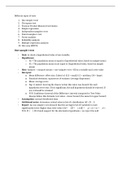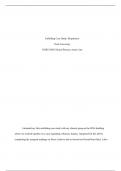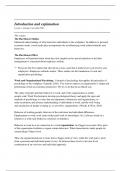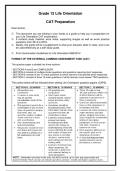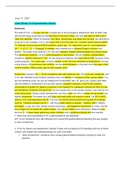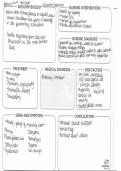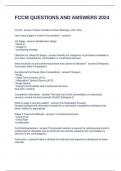SV Risk Communication
Lecture 1
Risk: consequence + likelihood
- deals with loss of something we value
- Uncertainty
- A formula that combines the above elements
Risk governance
Cross cutting aspects: communication, stakeholder engagement, context
,Adequate risk communication helps people understand the facts that are truly relevant to
their own life, so that they can make informed decisions. Consider respect factors like:
emotion, trust, control, uncertainty, dread, others that can increase/decrease fears.
It should both consider the role of the public AND the role of experts/institutions: establishing
trustworthiness.
- the role different stakeholders play in the risk arena.
Lecture 2 Risk information and the role of knowledge
Among different stakeholders: difference in level of knowledge, expertise, power
(money, lobbying), beliefs.
Deep core beliefs, policy core beliefs, secondary beliefs.
Target audience
Experts rank risks lower than lay people. Experts see risks as the probability of harm or expected mortality,
lay people have a broader concept that also includes uncertainty, dread, catastrophic potential, controllability,
equity, risk to future generations, etc. (more feelings involved)
Actual knowledge vs self-assessed knowledge (people often think they know more than they do).
Different goals of risk communication:
- Raising understanding
- Changing attitudes, behavior
- (joint) decision making
When effective:
- Risk awareness
- Understanding
- Informed consent
Generic model:
1. Exposure: type of channel, type of risk. Confirmation bias > polarization,
echochambers.
And Attention: use of design/format, framing
2. Understanding & acceptance. Information processing > level of uncertainty
(numeracy, science knowledge and truthness, distrust)
epistemic (lack of knowledge) and evaluative uncertainty
mental models: knowledge structures someone runs or simulates to make inferences and solve
problems – experts vs lay people’s mental models
3. Evaluative reactions and behavioral tendencies.
, a. Reactions: cognitive >mental models). Affective/emotional (fear). Extended
parallel process model EPPM
b. Behavioral preferences: influence efficacy, culture (culture theory), self-
efficacy, outcome expectations. theories should help target and tailor.
4. Behavioral response. Influence of contextual factors. Effective warning messages.
Retention and maintenance.
risk information processing model Bostrom
- Knowledge deficit model: by providing more information, behavior change will be
established.
- Confirmation bias. Easier to reject some things.
Practical applications:
- Informational campaigns
- Outreach toward domain-specific knowledge, not combatting non-factual claims
- Smartphone app, manageable modules
Cultural theory, Risk perception reflects and reinforces commitments to visions of how society should be
organized. People choose what to fear in order to support their cultural way of life. Group (collective vs
individualistic) vs grid (social stratification or not). 4 worldviews: hierarchism, individualism, egalitarianism,
fatalism. Worldview influences risk perception (but only minor)
Lecture 1
Risk: consequence + likelihood
- deals with loss of something we value
- Uncertainty
- A formula that combines the above elements
Risk governance
Cross cutting aspects: communication, stakeholder engagement, context
,Adequate risk communication helps people understand the facts that are truly relevant to
their own life, so that they can make informed decisions. Consider respect factors like:
emotion, trust, control, uncertainty, dread, others that can increase/decrease fears.
It should both consider the role of the public AND the role of experts/institutions: establishing
trustworthiness.
- the role different stakeholders play in the risk arena.
Lecture 2 Risk information and the role of knowledge
Among different stakeholders: difference in level of knowledge, expertise, power
(money, lobbying), beliefs.
Deep core beliefs, policy core beliefs, secondary beliefs.
Target audience
Experts rank risks lower than lay people. Experts see risks as the probability of harm or expected mortality,
lay people have a broader concept that also includes uncertainty, dread, catastrophic potential, controllability,
equity, risk to future generations, etc. (more feelings involved)
Actual knowledge vs self-assessed knowledge (people often think they know more than they do).
Different goals of risk communication:
- Raising understanding
- Changing attitudes, behavior
- (joint) decision making
When effective:
- Risk awareness
- Understanding
- Informed consent
Generic model:
1. Exposure: type of channel, type of risk. Confirmation bias > polarization,
echochambers.
And Attention: use of design/format, framing
2. Understanding & acceptance. Information processing > level of uncertainty
(numeracy, science knowledge and truthness, distrust)
epistemic (lack of knowledge) and evaluative uncertainty
mental models: knowledge structures someone runs or simulates to make inferences and solve
problems – experts vs lay people’s mental models
3. Evaluative reactions and behavioral tendencies.
, a. Reactions: cognitive >mental models). Affective/emotional (fear). Extended
parallel process model EPPM
b. Behavioral preferences: influence efficacy, culture (culture theory), self-
efficacy, outcome expectations. theories should help target and tailor.
4. Behavioral response. Influence of contextual factors. Effective warning messages.
Retention and maintenance.
risk information processing model Bostrom
- Knowledge deficit model: by providing more information, behavior change will be
established.
- Confirmation bias. Easier to reject some things.
Practical applications:
- Informational campaigns
- Outreach toward domain-specific knowledge, not combatting non-factual claims
- Smartphone app, manageable modules
Cultural theory, Risk perception reflects and reinforces commitments to visions of how society should be
organized. People choose what to fear in order to support their cultural way of life. Group (collective vs
individualistic) vs grid (social stratification or not). 4 worldviews: hierarchism, individualism, egalitarianism,
fatalism. Worldview influences risk perception (but only minor)

